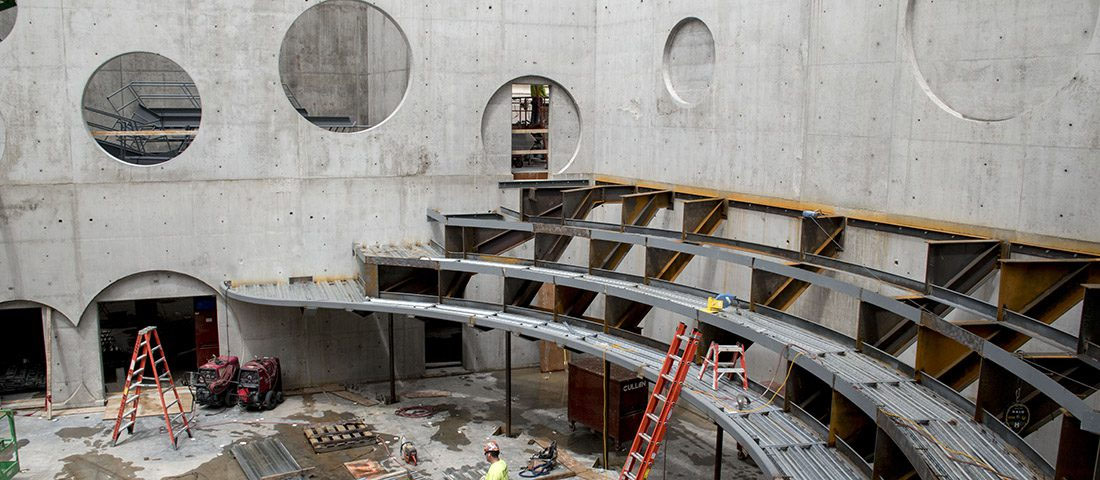Before they could design concert and recital halls with high-quality acoustics at the University of Wisconsin – Madison’s new Hamel Music Center, engineers were faced with the challenge of mitigating sound interference from one of the noisiest intersections on campus.
In its simplest premise, Strang’s DESIGN SYNCHRONICITY approach to project management empowers entire teams to collaborate, create and coalesce behind our client’s vision. That is certainly the case with the new Hamel Music Center at the University of Wisconsin, Madison.
Together with our contemporaries from Holzman, Moss Bottino Architecture and Talaske | Sound Thinking, our team integrated Design Synchronicity principles to address one of the most critical components of performing arts centre design: sound quality.
The goal is to create a truly unique acoustic presence – an actual performance extension of the artist’s voice or instruments. From the outset, the Hamel Music Center was to be a creative venue like no other, one that captures “The Wisconsin Sound” where artists worldwide acknowledge, “This is where I sound my best.” To achieve that, our team would have to conquer a daunting challenge – location.
Situated at the gateway to the University’s Arts District – our University’s front door – this 63,000 SF facility is located at one of the busiest and nosiest intersections on campus. So, how do we keep the traffic and commercial noise out while insulating beautiful compositions within? Designers started by using advanced technology to measure ambient noise levels surrounding the building. That data was invaluable in designing an exterior wall system of heavy precast concrete followed by an exacting air cavity and then interior walls.
And while that configuration will address the noise, no one desired the building to look like a fortress. In fact, one of the client’s visions was to design in “visual transparency,” welcoming observation and interaction between musicians and citizenry. That’s why on one corner you will see floor-to-ceiling glass showcasing activities within a rehearsal hall. To address noise infiltration here, designers specified double-glazed heavy glass, then (like above) a precise air pocket and then another layer of heavy glass.
Inside, double interior walls and acoustically-isolated joints will keep the three music halls secluded from each other. Entranceways will feature two sets of doors, further isolating light and sound. And HVAC systems will be isolated below the lobby to dispatch that noise.
Our next post will focus on how designers are working to create state-of-the-art acoustics in the concert hall. Until then, shhhhh, the performance is about to begin.
Together with our contemporaries from Holzman, Moss Bottino Architecture and Talaske | Sound Thinking, our team integrated Design Synchronicity principles to address one of the most critical components of performing arts centre design: sound quality.
The goal is to create a truly unique acoustic presence – an actual performance extension of the artist’s voice or instruments. From the outset, the Hamel Music Center was to be a creative venue like no other, one that captures “The Wisconsin Sound” where artists worldwide acknowledge, “This is where I sound my best.” To achieve that, our team would have to conquer a daunting challenge – location.
Situated at the gateway to the University’s Arts District – our University’s front door – this 63,000 SF facility is located at one of the busiest and nosiest intersections on campus. So, how do we keep the traffic and commercial noise out while insulating beautiful compositions within? Designers started by using advanced technology to measure ambient noise levels surrounding the building. That data was invaluable in designing an exterior wall system of heavy precast concrete followed by an exacting air cavity and then interior walls.
And while that configuration will address the noise, no one desired the building to look like a fortress. In fact, one of the client’s visions was to design in “visual transparency,” welcoming observation and interaction between musicians and citizenry. That’s why on one corner you will see floor-to-ceiling glass showcasing activities within a rehearsal hall. To address noise infiltration here, designers specified double-glazed heavy glass, then (like above) a precise air pocket and then another layer of heavy glass.
Inside, double interior walls and acoustically-isolated joints will keep the three music halls secluded from each other. Entranceways will feature two sets of doors, further isolating light and sound. And HVAC systems will be isolated below the lobby to dispatch that noise.
Our next post will focus on how designers are working to create state-of-the-art acoustics in the concert hall. Until then, shhhhh, the performance is about to begin.





